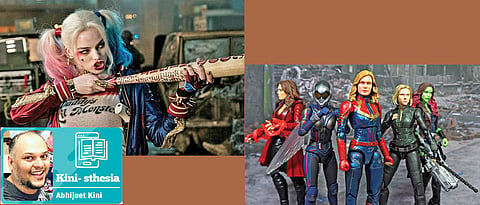

A common trope in pulp fiction used to be the classic damsel in distress. Several covers of these pulp novels featured a skimpily clad woman, who is rescued by a oh-so-macho muscleman hero, from the evil characters surrounding her. These books had a sole purpose, to entertain while titillating.
Such portrayal of women was not restricted to this medium alone. It was everywhere, and surprisingly, in comics too! The medium of comics that was supposed to introduce us to glorified heroes during the times of World War, slowly turned into a platform where male heroes got much more going than their female counterparts. Several storylines and cover artworks featured a very pulp-like format, with the same semi-naked heroines and the testosterone pumped heroes. This was especially true in the sword-and-sorcery genre in the silver age of comics, which featured barbarians, wizards and the like. Think Conan, Kull the Conqueror etc.
Things changed gradually, and today we see a very different portrayal of female superheroes. My earliest exposure to strong female characters in pop culture or superhero movies was Batman Returns. Michelle Pfeifer had a fantastic outing as the lethal Catwoman in the movie. Sexualised, sure, but not exploited. She redefined the comic version of the character and gave us a performance which at times topped Batman’s presence on screen. Tim Burton may have overdone a few things here and there in it, but Batman Returns remains one of my favourite Batman movies ever.
Star Wars gave us Princess Leia, the fearless agent of the Rebel Alliance. Though many would argue that the original trilogy focussed a lot more on glorifying Luke, her brother, it was Leia who sets the ball rolling at the beginning. She is strong and highly motivated, and with her classic costume and hairdo, she remains a much loved character from the space epic.
However, in the 1983 film, Return of the Jedi, Princess Leia adorned that now-iconic bikini-costume (when she’s Jabaa’s slave) which got people to question how the makers had suddenly objectified and sexualised a strong female character. Heck, even late actress Carrie Fisher hated the costume! Apart from this episode though, the character definitely is counted as an important female pop culture icon.
And, now let’s turn to Wonder Woman. Created by psychologist and writer Dr William Marston, the character was seen as a representative of the modern or new age woman. She was able to do all the super-stuff, and was strong enough to take on even Superman. It was later revealed by Dr Marston that his inspiration in creating the character came from his own sexual encounters and fantasies. No wonder (pun intended), she was shown bound, gagged and using whips through her adventures.
It makes you see the character rather differently once you know this fact. Wonder Woman too was seen as an objectified superheroine, but not for long. Recent outings in comic book adventures as well as the hugely popular cinematic version portrayed by Gal Gadot sees the character of Wonder Woman redefine the rules of superhero flicks.
And with Marvel’s wave of superheroines, such as Black Widow, Captain Marvel and other strong characters such as Shuri, Gamora, etc, the movie studios have made sure that these awesome women are brought onto the silver screen and thus create a place in the roster of names ruling pop culture. The fact that Captain Marvel is considered the strongest entity in the Marvel Cinematic Universe (MCU) says a lot about how the studio wants to take this message across. Who can forget her (rather short) battle with Thanos in Endgame? Wish we saw more of that fight happen. Not to mention that little tribute to the ‘girl-power’ of MCU, when all the leading female characters band up together and fight!
DC has already cemented Harley Quinn as a top billed female character from their stable. Many saw her as the biggest plus of Suicide Squad, and with the recent Birds of Prey, DC brought to the fore some more of their badass females, namely the Huntress, Black Canary, Renee Montoya, etc. Wonder Woman 2 is already on its way and if one goes by the roster of movies and TV shows coming up, there’s ample girl power there as well.
To make my point, gender roles have changed for the good in the superhero genre. The comics as well as the movies have ensured that stereotypical heroines have made way for stronger, much more dominant female characters. So the next time you hear someone say ‘she fights like a girl’, you better buckle up your seatbelts!
(The writer is a comic creator, illustrator and animator)
